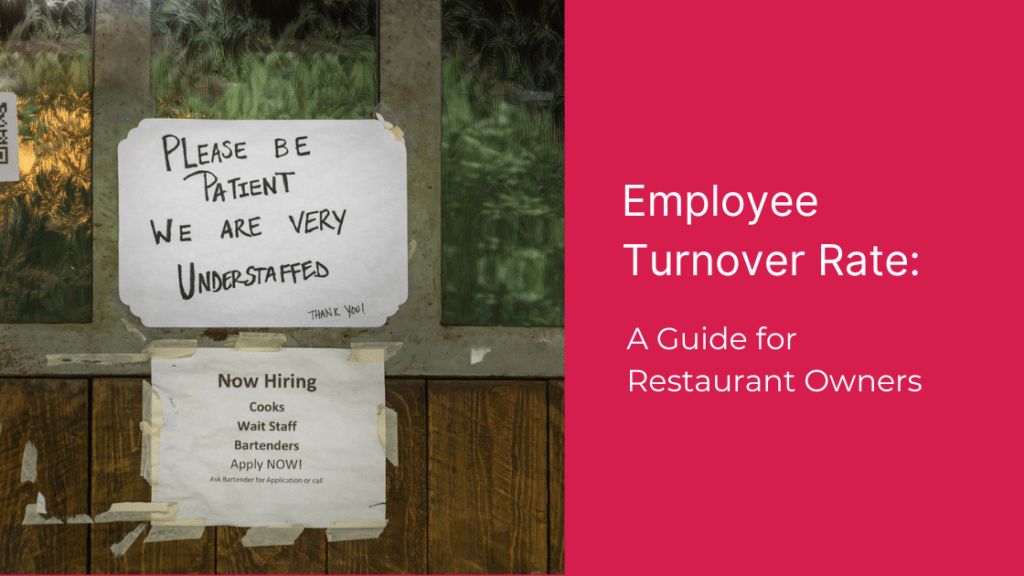As you navigate the challenging landscape of the hospitality industry, one key factor that significantly impacts your success is employee turnover. Understanding, managing, and optimizing turnover rates is crucial for maintaining a productive, happy, and efficient team. This chapter will provide you with a comprehensive understanding of restaurant employee turnover rate, its types, causes, and specifically focus on the unique dynamics within the restaurant sector.
What Is Employee Turnover Rate?
Employee turnover rate refers to the rate at which employees leave a company and are replaced by new hires. In the restaurant industry, where staff interaction and customer service play pivotal roles, managing turnover is particularly critical. Employee turnover can be seen both as a challenge and an opportunity, depending on its nature and the reasons behind it.
Voluntary Turnover vs. Involuntary Turnover
Turnover can be broadly classified into two categories: voluntary and involuntary. Understanding the distinction between voluntary and involuntary turnover is crucial for effective workforce management. Both forms of turnover impact the restaurant’s operations and require distinct strategies for mitigation.
Controllable
Voluntary turnover occurs when employees choose to leave, often due to better opportunities, dissatisfaction, or personal reasons. This type is somewhat controllable as improvements in management practices, work environment, and compensation can influence an employee’s decision to stay.
Uncontrollable
Involuntary turnover happens when the employer makes the decision, typically due to performance issues, restructuring, or economic downturns. This type is less controllable and often tied to broader business decisions and market conditions.
Proactive measures, such as creating a positive work environment, offering competitive benefits, and providing opportunities for skill development, can help minimize voluntary turnover. On the other hand, addressing performance issues, enhancing communication, and providing clear expectations can contribute to reducing involuntary turnover. Successful workforce management involves a comprehensive approach to both types of turnover, ensuring a stable and motivated team in the dynamic restaurant environment.
Desirable vs. Undesirable Employee Turnover
Not all employee turnover is harmful. Turnover is classified into desirable and undesirable categories, each carrying distinct implications for business operations.
Desirable turnover refers to situations where employees voluntarily leave for positive reasons, such as career advancement, pursuing higher education, or retirement. While this turnover is a natural part of workforce dynamics, it can contribute to a healthy organizational culture and provide opportunities for fresh talent infusion.
On the other hand, undesirable turnover involves the loss of valuable employees due to negative factors, such as dissatisfaction with working conditions, poor management, or lack of growth opportunities. Undesirable turnover can be detrimental to a restaurant’s performance, leading to disruptions in service, increased recruitment costs, and potential declines in team morale.
Restaurant managers aim to foster an environment that minimizes undesirable turnover by addressing employee concerns, providing training and development opportunities, and creating a workplace culture that values and retains top talent. Striking a balance between desirable and undesirable turnover is essential for sustaining a thriving and resilient restaurant team.
What Causes Undesirable Turnover?
Undesirable turnover refers to the loss of valuable and proficient employees, which can be detrimental to the business. Common contributors to undesirable turnover include poor working conditions, inadequate compensation, lack of career advancement opportunities, ineffective leadership or management practices, and a deficient organizational culture. When employees feel unsupported, undervalued, or stagnant in their roles, they may seek opportunities elsewhere, leading to undesirable turnover.
Additionally, unresolved conflicts, issues with work-life balance, and a perceived lack of recognition can contribute to employee dissatisfaction and turnover. It can often result in increased training costs, loss of expertise, and reduced team morale as well. Recognizing and addressing these factors is crucial for restaurant management to mitigate undesirable turnover, enhance employee satisfaction, and foster a positive work environment.
5 common causes of high employee turnover
- Workplace Changes: Significant changes in the workplace, like restructuring or changes in job roles, can lead to uncertainty and discomfort among employees, prompting them to leave.
- Compensation Problems: Inadequate or non competitive pay is a major factor. In the restaurant industry, where margins are often tight, balancing fair compensation with profitability is crucial.
- Bad Management: Poor management practices, lack of support, and inadequate communication can significantly increase turnover rates. Employees often leave managers, not jobs.
- Negative Workplace Environment: A toxic or unhealthy work environment, including harassment, favoritism, or lack of team spirit, can drive employees away.
- Career Advancement: Limited opportunities for career advancement or skill development can lead to turnover, as employees seek growth and new challenges elsewhere.
Why Does Restaurant Employee Turnover Rate Matter?
Employee turnover in restaurants is more than just a statistic; it’s a reflection of your business health. A high employee turnover rate can lead to several operational challenges:
- Consistency in Service: Frequent changes in staff can disrupt the consistency and quality of service, which is crucial for customer satisfaction and retention.
- Training Costs: Every new hire involves training costs. High turnover means recurrent training expenses, impacting your bottom line.
- Team Morale: Constant staff changes can affect the morale of your team, leading to a less engaged and less productive workforce.
- Reputation: The reputation of your restaurant is not only built on food and ambiance but also on the quality of service, which is directly linked to your staff’s expertise and happiness.
Understanding and managing turnover rates is essential for maintaining a high-quality, stable workforce that can drive your restaurant’s success.
How to Calculate Your Restaurant’s Employee Turnover Rate
Calculating the employee turnover rate in a restaurant is a crucial metric for assessing staff stability and overall management effectiveness. Here’s a step-by-step guide to accurately compute this rate:
Determine the Time Period: Choose a specific time frame for the calculation, such as a month, quarter, or year. This consistency in the time period is essential for meaningful comparisons over time.
Count the Number of Employees at the Start and End of the Period: At the beginning and end of your chosen period, count the total number of employees working in the restaurant. This includes full-time and part-time staff.
Calculate the Average Number of Employees: Add the number of employees at the start and end of the period, then divide by two. This gives you the average number of employees during that period.
Average Number of Employees = ( Employees at Start + Employees at End ) / 2
Determine the Number of Separations: Count how many employees left the restaurant, for any reason, during the time period. This includes resignations, terminations, and retirements.
Calculate the Turnover Rate: Divide the number of separations by the average number of employees, and then multiply by 100 to get the percentage.
Employee Turnover Rate (%) = ( Number of Separations / Average Number of Employees ) × 100
For example, if a restaurant started the year with 20 employees and ended with 18, and during the year 5 employees left, the calculation would be:
Turnover Rate = (5 / ((20 + 18) / 2 )) × 100 = ( 5 / 19 ) × 100 ≈ 26.32%
Understanding and managing the employee turnover rate is vital for restaurant operations. High turnover can indicate underlying issues like poor management, inadequate training, or lack of employee engagement.
By keeping track of this metric, restaurant managers can identify trends, understand the impact on operations and costs, and develop strategies to improve employee retention and satisfaction. SynergySuite can assist in tracking and analyzing these metrics, offering insights for better workforce management.
What Is a Good Employee Turnover Rate for a Restaurant?
Determining a good employee turnover rate for a restaurant involves finding a balance between retaining experienced staff and allowing for a healthy level of turnover that may bring in fresh perspectives. The restaurant industry typically experiences higher turnover rates compared to other sectors. While it varies by location and restaurant type, a good benchmark for turnover rates in the restaurant industry is around 75% annually. This allows for some natural movement in the workforce while retaining a core group of experienced employees.
However, striving for lower rates is beneficial. The key is to balance realistic expectations with efforts to reduce unnecessary turnover. It’s essential for restaurant managers to monitor turnover rates, analyze the reasons behind employee departures, and implement strategies to address any concerning trends.
How Do I Lower My Restaurant Employee Turnover Rate?
Reducing employee turnover rate is pivotal for the success and stability of your restaurant. Lowering restaurant employee turnover involves implementing strategies to create a positive work environment, foster employee engagement, and address underlying issues that may contribute to high turnover.
Start by conducting regular employee feedback sessions to understand their concerns and satisfaction levels. Implementing competitive and fair compensation, providing opportunities for skill development and advancement, and recognizing and rewarding employees for their contributions can significantly boost morale. By investing in your employees’ well-being, professional growth, and job satisfaction, you can create a workplace that encourages loyalty and commitment, ultimately leading to lower turnover rates in the long run. Here are strategies to achieve this:
Focus on the Hiring Process
Getting the right people on board from the start is crucial. Implement a thorough hiring process that assesses not just skills but also cultural fit and work ethic.
Ensuring a thorough and transparent recruitment process is essential to attract candidates who align with the restaurant’s values and culture. Clearly communicate expectations, job responsibilities, and growth opportunities during the hiring phase to set realistic expectations for potential employees. Conduct comprehensive interviews to assess both technical skills and cultural fit.
Implementing a robust onboarding program is crucial to acclimate new hires, providing them with the necessary training and resources to succeed in their roles. This might include:
- Structured interviews
- Work trials
- Reference checks
By investing time and effort into the hiring process, restaurants can not only reduce turnover but also build a team that is more likely to thrive and contribute to the overall success of the establishment.
Remembering the Golden Rule
Treat your employees as you would want to be treated. This simple principle can significantly impact employee satisfaction and loyalty.
Is It a Place You Would Want to Work?
Ask yourself if your restaurant is a place you’d be happy working in. Consider factors like work environment, team dynamics, management style, and benefits. If the answer is no, identify areas for improvement.
Understand Your People
Take the time to understand your employees’ individual needs and motivations. This might involve:
- Regular one-on-one meetings.
- Creating a feedback culture.
- Recognizing and rewarding good performance.
3 Ways Restaurant Back of House Helps Employee Retention
The back of the house (BOH) is the heart of your restaurant operations. Improving the work environment and processes here can significantly enhance employee retention.
1. Internal Opportunities for Advancement
One of the most effective retention strategies is providing clear paths for career advancement. This includes:
- Offering training programs to develop skills
- Promoting from within whenever possible
- Creating new roles or responsibilities for promising employees
- These steps not only motivate your staff but also help you build a strong, skilled team
2. Respect for Schedules
Respecting your staff’s time and personal life is crucial. This can be achieved by:
- Creating fair and predictable schedules
- Accommodating personal requests when feasible
- Avoiding last-minute schedule changes
- Implementing a quality employee scheduling system
A well-managed schedule demonstrates respect for your employees’ time, leading to greater job satisfaction and lower turnover.
3. Onboarding That Works
A structured onboarding process for new hires can set the tone for their entire tenure. Ensure it includes:
- Comprehensive training covering all aspects of their role
- Introduction to the team and company culture
- Regular check-ins during the initial employment period
Effective onboarding can help new hires feel valued and integrated into your team.
The Outlook on Restaurant Turnover Going Forward
Looking ahead, the restaurant industry will continue to face challenges related to employee turnover. However, by implementing the strategies discussed above, you can better manage and reduce turnover in your restaurant. It’s important to stay adaptable, responsive to employee needs, and proactive in creating a positive work environment.
Remember, reducing turnover isn’t just about cutting costs; it’s about building a strong, cohesive team that contributes to the overall success of your restaurant. Investing in your employees is investing in the future of your business.
By understanding the nuances of employee turnover and taking concrete steps to address them, you can create a more stable, efficient, and productive work environment that benefits both your staff and your bottom line.
Stay on Top of Your Restaurant Analytics with SynergySuite
Being able to readily stay on top of your data, and make informed decisions based on that data, it’s absolutely critical to have implemented a quality restaurant reporting and analytics platform like SynergySuite.
Many of the problems and challenges of running a restaurant can be solved or avoided with the right restaurant reporting tools. We offer restaurant analytics software that captures and presents your data in an easy-to-understand dashboard. We make it simple to use your valuable data to save time, improve profitability, and ensure compliance with regulations.
Schedule a demo today to see how SynergySuite can help you take your restaurant business to the next level.





